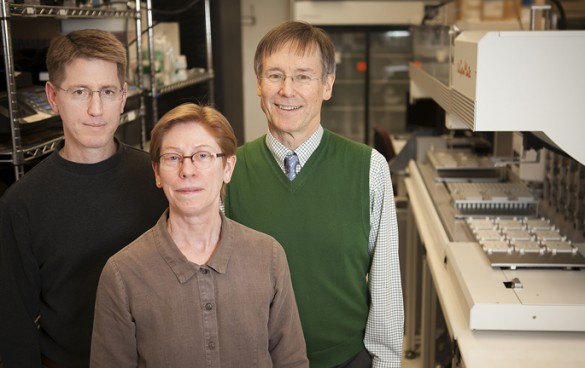
A gene on chromosome 8 — in a region of the genome linked to risk for many types of cancer — is particularly associated with prostate cancer susceptibility, Vanderbilt University researchers have found.
The gene is related to a master regulator of embryonic stem cells — cells that can regenerate themselves and produce all other cell types — suggesting that it could promote stem cell-like regeneration to initiate cancer.
The findings, reported March 6 in the American Journal of Human Genetics, support an “intriguing link” between stem cell properties and the origins of cancer, said senior author Jeffrey Smith, M.D., Ph.D., associate professor of Medicine and Cancer Biology.
Genome-wide association studies have repeatedly found genetic variants in a region of chromosome 8 that increase risk for cancers including prostate, colon, breast, ovarian and others. But the region appeared to be a “gene desert” — a part of the genome with relatively few genes, Smith said.
“Of course the million dollar question has been: what the heck there is increasing cancer risk?” Smith said.
In their analysis of the chromosome 8 region, Smith’s group noticed a “retrogene” — a copy of another gene that has reinserted into a different spot in the genome. The retrogene on chromosome 8, called POU5F1B, is a copy of the master stem cell regulator Oct4. Other studies have demonstrated that Oct4 can confer stem cell-like properties to non-stem cells. The retrogene appeared to be intact, Smith said, suggesting that if it were “turned on,” it might function like Oct4.
Smith and his team investigated whether POU5F1B was associated with cancer risk. With data from an international effort — The Cancer Genome Atlas (TCGA) Project — they demonstrated that risk variants in the chromosome 8 region correlated with the expression level of POU5F1B in normal prostate tissue. They also found two sites within the retrogene that were predicted to alter expressed protein in a deleterious way, and that were also associated with prostate cancer risk.
Smith stressed that the studies show association, not cause.
“We can’t say with certainty that this gene causes the cancer,” he said. “But it does point a gigantic red arrow saying, ‘look here,’ and the association of this retrogene to cancer risk has some interesting implications for cancer biology in general,” Smith said.
“Is what goes wrong in a tumor related to stem cells?,” he asked.
Other studies also have supported a connection between stem cells and cancer. Overexpression of Oct4 in mice causes cells to transform and grow out of control, and human tumors with stem cell-like patterns of gene expression are more aggressive and patients with these tumors have a worse prognosis, Smith said.
Smith and his team also used a computational analysis to examine a large number of genetic variants associated with prostate cancer risk and determine if they had any relationship to genes known to be important to stem cell signaling.
They found a correlation “between the genetic predisposition to prostate cancer — the transformation from normal to tumor — and a network of genes related to the properties of stem cells,” Smith said.
“This could be an important piece of the puzzle in understanding the origins of cancer,” he said.
Contributors to the current study include Joan Breyer and William Dupont, Ph.D., professor of Biostatistics. The research was supported by a MERIT grant from the U.S. Department of Veterans Affairs and by an award from the V Foundation.












